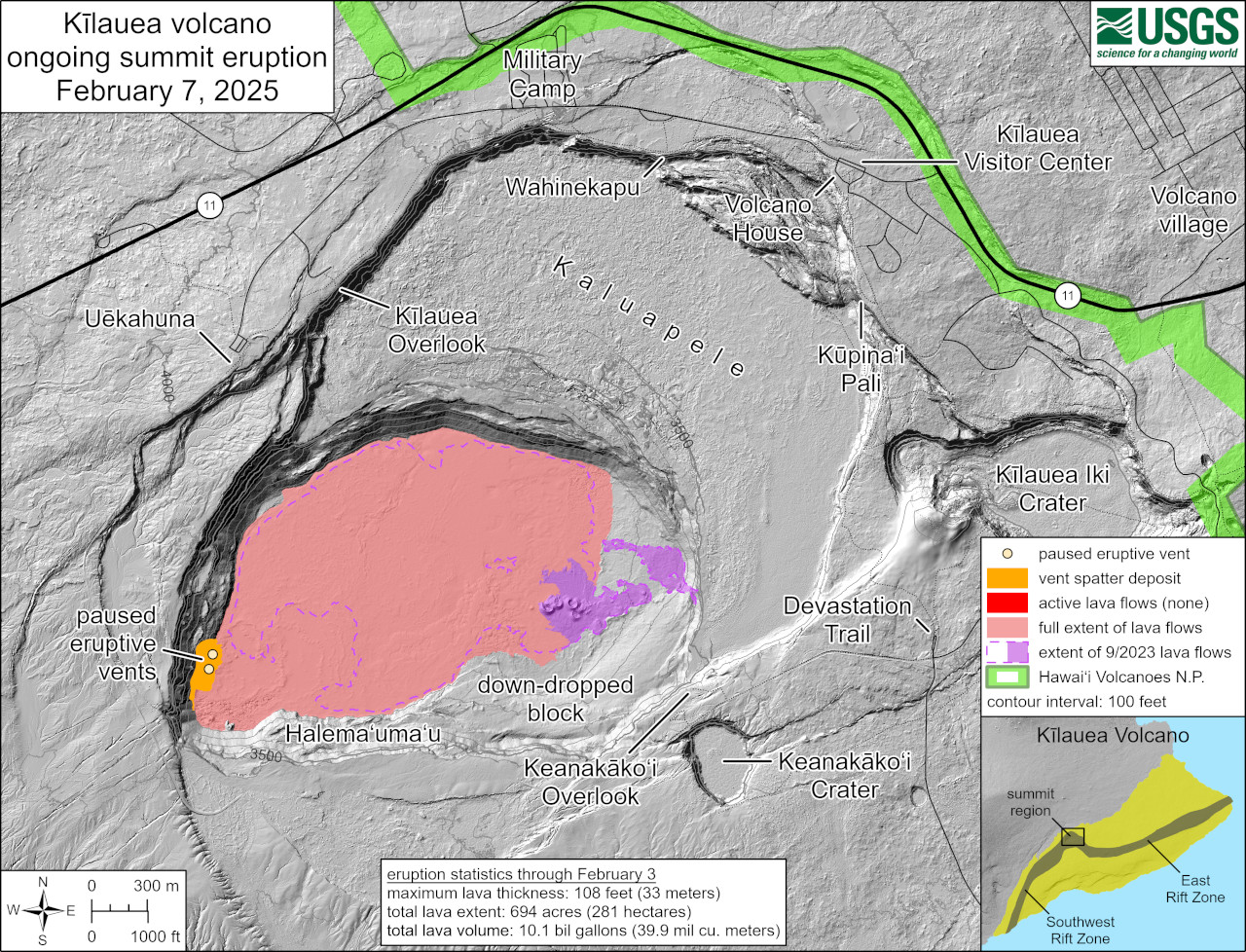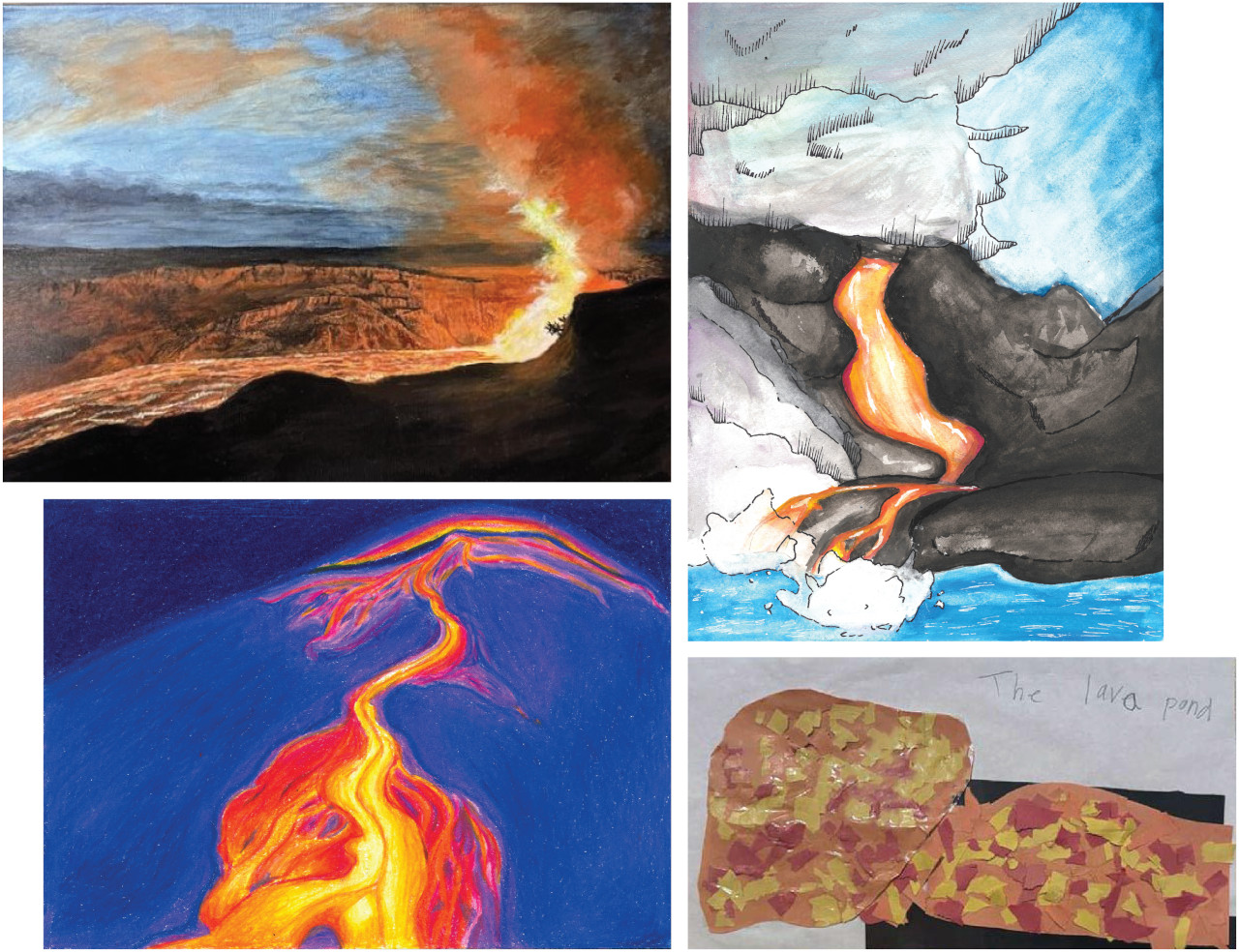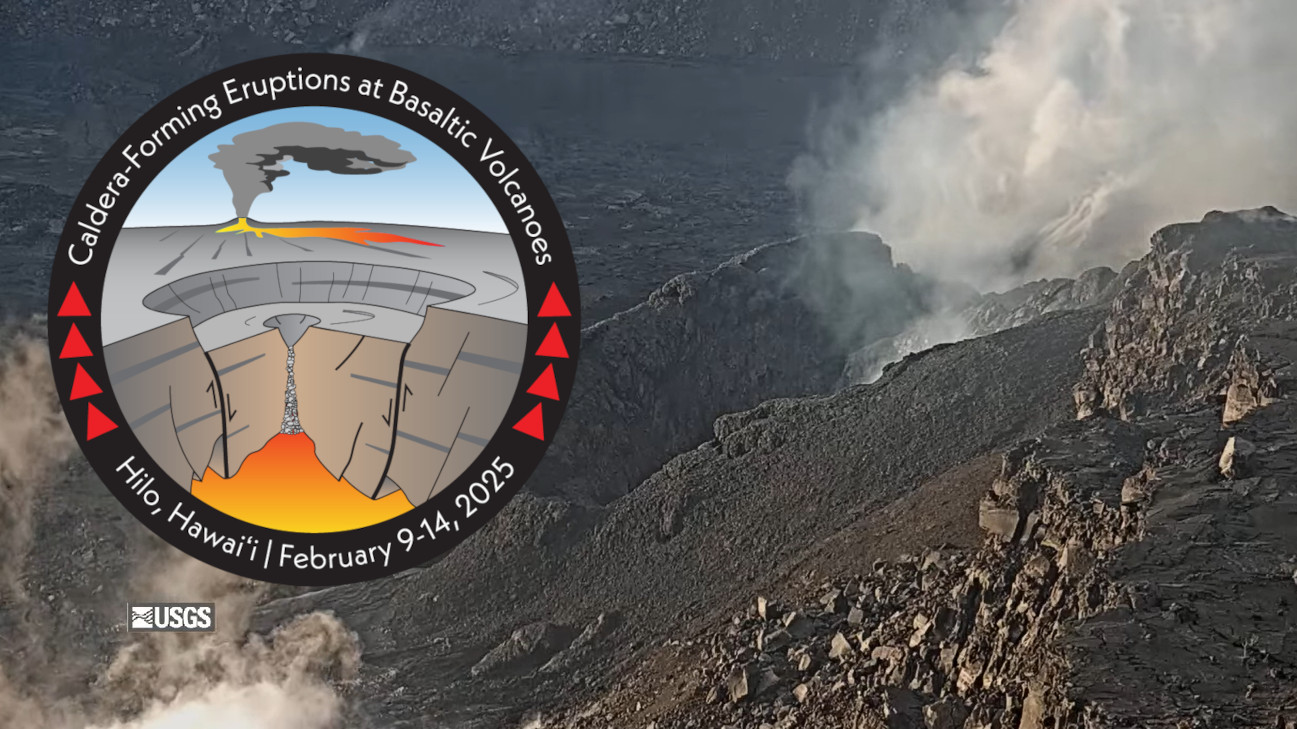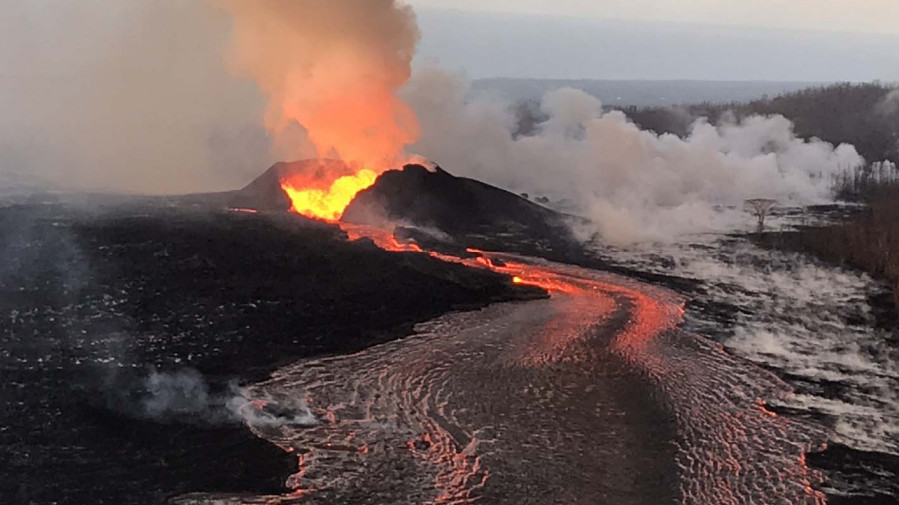
USGS: “This reference map depicts the Kīlauea summit eruption within Halema‘uma‘u crater that began on December 23, 2024. As of this posting on February 7, the eruption has had eight episodes. However, most of the map data included here were collected during a Hawaiian Volcano Observatory helicopter overflight on February 3, prior to the eighth episode that began later the same day. For this reason, the provided statistics only reflect the first seven episodes of the eruption. No lava flows are currently active on the crater floor, but persistent glow from the eruptive vents indicates that lava remains close to the surface.”
(BIVN) – The ongoing eruption at the summit of Kīlauea remains paused, and the USGS Alert Level for the volcano is at WATCH.
Scientists calculate a new eruptive episode (Episode 9) may begin within the next 4 days in Hawaiʻi Volcanoes National Park.
This week’s Volcano Watch article on the American Geophysical Union Chapman Conference in Hilo is by HVO geologist Kendra J. Lynn:
What is the collective noun for a group of volcano scientists? While some tongue-in-cheek responses might be “an eruption of volcanologists” or “a swarm of seismologists,” we’ll stick to “an assembly of volcano scientists.”
Next week, during February 9-14, volcano scientists from around the world are gathering in Hilo, united by the common goal of understanding caldera-forming eruptions at basaltic volcanoes.
The occasion for the assembly is the American Geophysical Union Chapman Conference on Caldera-forming Eruptions at Basaltic Volcanoes: Insights and Puzzles from Kīlauea 2018 and Beyond. The meeting is directly aligned with the U.S. Geological Survey’s Volcano Hazards Program mission—“to enhance public safety and minimize social and economic disruption from volcanic unrest and eruption.”
Basaltic caldera-forming rift eruptions, like the 2018 eruption of Kīlauea, represent an underappreciated hazard for many global communities, but also a chance to better understand some of Earth’s most active volcanoes. A handful of these eruptions have been documented globally in the last half-century, including at Miyakejima (Japan), Piton de la Fournaise (La Réunion), and Bárðarbunga (Iceland). Kīlauea’s 2018 eruption was its most impactful in centuries, was documented in remarkable detail, and it involved more than one cubic kilometer of basaltic lava flows, a magnitude-6.9 flank earthquake, and a major summit collapse.
Observations from Kīlauea and similar eruptions around the globe offer an unprecedented opportunity to understand calderas and associated rift systems and the dynamics of their interplay, but a community-driven synthesis has been lacking, and numerous fundamental scientific questions remain. The experts who will gather on the Island of Hawaiʻi will assess current understanding, share insights, and map out work on critical outstanding issues. Resulting insights should prove valuable when the next large basaltic caldera collapse takes place somewhere on Earth.
This conference will bring together an interdisciplinary assembly of volcano scientists to contrast observations from historic global caldera-rift eruptions, establish the state-of-the-art understanding, identify important questions, and initiate lasting new research efforts. We will address the causes of these eruptions, the dynamics of basaltic caldera collapses, the interaction between summit calderas and rift zones, the geometry and physical properties of magma storage, and the challenges in forecasting associated hazards.
A significant investment in research and monitoring of Hawaii’s volcanoes was made through the Additional Supplemental Appropriations for Disaster Relief Act of 2019 (H.R. 2157), which provided Supplemental funding to USGS for recovery and rebuilding activities in the wake of the 2018 Kīlauea eruption. Results from recent large-scale science experiments at Kīlauea supported by this funding will be shared and discussed at the Chapman. Field trips will give participants an opportunity to visit important sites on the volcano. Finally, teams will be formed to discuss science questions in detail and establish priorities for additional work following the meeting.
The conference is being organized by U.S. Geological Survey and academic volcano researchers, bringing over 150 scientists together for presentations, discussions, workshops, and field trips. Participants represent 15 countries outside the United States and will include presentations about volcanoes around the world. Roughly 25% of presenters are undergraduate or graduate students, representing a new generation of volcano scientists tackling our field’s biggest challenges. We are very excited that several University of Hawai‘i at Hilo and Mānoa students will be presenting their research at the meeting. Additionally, partners from Hawai‘i County Civil Defense, Hawai‘i Volcanoes National Park, the Hawaiian Volcano Education & Resilience Institute, the Pacific Tsunami Museum, and the Pacific Tsunami Warning Center will participate.

Art contest winners. From the USGS: “In the upper left, Linda Hansen from Pāhoa, submitted a painting titled “Kīlauea welcomes Christmas 2024” that won in the adult division. In the lower left, Kaʻū High and Pāhala Elementary School 11th grader Añaza Nielsen won the high school category with their colored pencil artwork titled “Volcanic Activity,” which depicts the 2022 Mauna Loa eruption as a thermal image. The upper right shows “Lava Flow,” a watercolor and ink piece by Andrea Yanga, an 8th grader also attending Kaʻū High and Pāhala Elementary School who won in the middle school division. The lower right shows a lava pond created with construction paper by Milunaizarra Peltier, a 5th grader from Volcano School of Arts & Sciences, who won the elementary art division.” (USGS photo)
During the week of the conference, winning art and haiku submissions from the USGS Hawaiian Volcano Observatory (HVO) Volcano Awareness Month competition will be on display. In addition, a public After Dark in the Park presentation by Icleandic Meteorological Office scientist Gro Pederson will summarize the ongoing volcanic crisis on Reykjanes Peninsula, Southwest Iceland on February 6 in the Kīlauea Visitor Center Auditorium in Hawai‘i Volcanoes National Park. Dr. Pederson is a former USGS HVO volunteer, and her presentation will highlight parallels between Hawaiian and Icelandic volcanoes and their hazards to our communities.
We look forward to a productive week learning from our colleagues and partners. E komo mai to the assembly of volcanologists that is soon to arrive!



by Big Island Video News7:36 am
on at
STORY SUMMARY
HILO, Hawaiʻi - This week, the USGS Hawaiian Volcano Observatory writes about the American Geophysical Union Chapman Conference from February 9 to 14th.